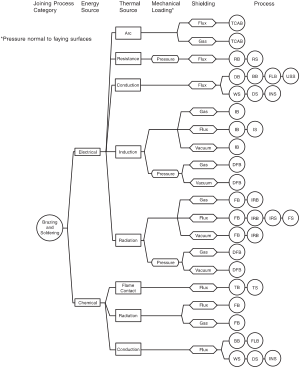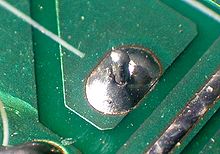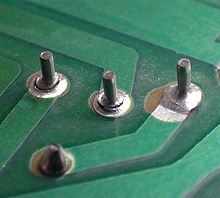Soldering
Soldering is an important skill for many industries and hobbies, and it requires a combination of technical knowledge and practical experience to achieve good results.Soldering provides reasonably permanent but reversible connections between copper pipes in plumbing systems as well as joints in sheet metal objects such as food cans, roof flashing, rain gutters and automobile radiators.Automated methods such as wave soldering or use of ovens can make many joints on a complex circuit board in one operation, vastly reducing production cost of electronic devices.Titanium, magnesium, cast irons, some high-carbon steels, ceramics, and graphite can be soldered but it involves a process similar to joining carbides: they are first plated with a suitable metallic element that induces interfacial bonding.A eutectic formulation has advantages when applied to soldering: the liquidus and solidus temperatures are the same, so there is no plastic phase, and it has the lowest possible melting point.The fraction represent percentage of tin first, then lead, totaling 100%: For environmental reasons and the introduction of regulations such as the European RoHS (Restriction of Hazardous Substances Directive), lead-free solders are becoming more widely used.Other common solders include low-temperature formulations (often containing bismuth), which are often used to join previously soldered assemblies without unsoldering earlier connections, and high-temperature formulations (usually containing silver) which are used for high-temperature operation or for first assembly of items which must not become unsoldered during subsequent operations.Soft soldering uses the lowest temperatures (and so thermally stresses components the least) but does not make a strong joint and is unsuitable for mechanical load-bearing applications.Soldering operations can be performed with hand tools, one joint at a time, or en masse on a production line.Soft soldering can be done with a heated iron whereas the other methods typically require a higher temperature torch or a furnace to melt the filler metal.The American Welding Society defines brazing as using filler metals with melting points over 450 °C (842 °F) — or, by the traditional definition in the United States, above 800 °F (427 °C).Plumbing and automotive applications, among others, typically use an acid-based (hydrochloric acid) flux which provides rather aggressive cleaning of the joint.These fluxes cannot be used in electronics because their residues are conductive leading to unintended electrical connections, and because they will eventually dissolve small diameter wires.During WW2 and for some time afterwards SOE forces used small pyrotechnic self-soldering joints to make connections for the remote detonation of demolition and sabotage explosives.With resistance soldering an intense heat can be rapidly developed directly within the joint area and in a tightly controlled manner.Active soldering has been shown to effectively bond ceramics,[29] aluminium, titanium, silicon,[30] graphite and carbon nanotube based structures [31] at temperatures lower than 450 °C or use of protective atmosphere.In the hands of a skilled tradesman, the hotter flame of acetylene, MAPP, or propylene allows more joints to be completed per hour without damage to copper tempering.The pliers-like tool uses heated fitted jaws that completely encircle the pipe, allowing a joint to be melted in as little as 10 seconds.Internal and external wire brushes are available for the common pipe and fitting sizes; emery cloth and wire-wool are frequently used as well, although metal wool products are discouraged, as they can contain oil, which would contaminate the joint.Many plumbing solder formulations are available, with different characteristics, such as higher or lower melting temperature, depending on the specific requirements of the job.For attachment of electronic components to a PCB, proper selection and use of flux helps prevent oxidation during soldering; it is essential for good wetting and heat transfer.Cold-soldered joints also happen in mass production, and are a common cause of equipment which passes testing, but malfunctions after sometimes years of operation.Excessive heating of a PCB may result in delamination — the copper traces may actually lift off the substrate, particularly on single sided PCBs without through hole plating.Plastic or metal mounting clips or holders may be used with large devices to aid heat dissipation and reduce joint stresses.If such fluxes are used, cleaning may merely be a matter of aesthetics or to make visual inspection of joints easier in specialised 'mission critical' applications such as medical devices, military and aerospace.Water, alcohol, acetone, or other solvents compatible with the flux and the parts involved are commonly used with cotton swabs or bristle brushes.Sometimes, to prevent movement they are temporarily kept in place with small dabs of adhesive or secured with a fixture, then the assembly is passed over flowing solder in a bulk container.Up to 4000 W can be used in the heating element, allowing fast soldering, good results with connections requiring high energy.The RoHS directives in the European Community required many new electronic circuit boards to be lead-free by 1 July 2006, mostly in the consumer goods industry, but in some others as well.JEDEC has created a classification system to help lead-free electronic manufacturers decide what provisions to take against whiskers, depending upon their application.









SolderDry contactCold junction (thermocouple)filler metalelectronics industryprinted circuit boardsplumbingmetalworkhot air gunsbrazingstained glassflashingroof flashingrain guttersradiatorsJewelrycopper foilelectrical wiringelectronic componentswave solderingSolderabilitymild steelnickelstainless steelTitaniummagnesiumcast ironssteelsceramicsgraphitealloyseutecticaluminiumliquidussolidusRestriction of Hazardous Substances Directivebismuthsilverclassification chartwettingcapillary actiontensile strengthsoldering ironsoldering gunAmerican Welding SocietyUnited States Military StandardFlux (metallurgy)oxidationcharcoalreducing agentwetting agentsurface tensionpine treeshydrochloric acidCitric acidcorrosivesolder potprinted wiring boardsheating elementplatedreworksurface mountsheet metaltin platedthermal massbody solderspot weldingSuzanne JennichesWavelengthslensesflashlampsphotonic curingSAC305induction heatingalternating currentresistive heatinginfraredfibersconnectorsterminalsultrasonic solderingzirconiumchromiumrare-earth elementsceriumlanthanumgalliumpropane torchacetylenepropylenetradesmanopen flamesdo-it-yourselfplierssolder ring fittingsemery clothBuilding codesdrinking waterbrass instrumentswoodwindWire brushwire woolbrazierthrough-holesurface-mount chipball grid arraycircuit boardnon-eutecticthrough hole platingheat sinkgermaniumlacquerDesolderingRework (electronics)desoldering braidssolder suckerswave solderedreflow solderedstanding wavesolder pastesurface mountedEuropean Communitytin whiskersDip solderingElectronics technicianSolder fatigue